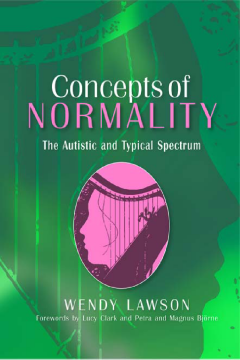
Additional Information
Book Details
Abstract
For those with autism, understanding `normal' can be a difficult task. For those without autism, the perception of `normal' can lead to unrealistic expectations of self and others. This book explores how individuals and society understand `normal', in order to help demystify and make accessible a full range of human experience.
Wendy Lawson outlines the theory behind the current thinking and beliefs of Western society that have led to the building of a culture that fails to be inclusive. She describes what a wider concept of `normal' means and how to access it, whether it's in social interaction, friendships, feelings, thoughts and desires or various other aspects of `normality'. Practical advice is offered on a range of situations, including how to find your role within the family, how to integrate `difference' into everyday society, and how to converse and connect with others.
Accessible and relevant to people both on and off the autism spectrum, this book offers a fresh look at what it means to be `normal'.
Wendy Lawson is a mother of four, who was originally diagnosed as being intellectually disabled, then in her teens as being schizophrenic, and finally in 1994, as having an autism spectrum disorder. She has been married, separated and divorced, has experienced the death of one of her teenage sons, gone through moving from one country to another, losing friends and status due to being openly gay, faced ill health and recently come to terms with the fact that she is aging! Her youngest son was diagnosed at the age of 12 as having Asperger's Syndrome. As a qualified counsellor, social worker and psychologist Wendy has operated her own private practice for many years.
Table of Contents
| Section Title | Page | Action | Price |
|---|---|---|---|
| PART I – M4P: What is it and how does it work? | |||
| 1. Introduction | |||
| 2. Applying M4P in the Informal Sector: the case of Savings Groups | |||
| 3. Market System Diagrams: or, how I learned to stop worrying and love the doughnut | |||
| 4. Measuring What Matters: Monitoring and Results Measurement | |||
| 5. Getting to Scale | |||
| 6. The Art of Market Facilitation: Lessons from FSD Kenya | |||
| PART II – Expanding the Application of M4P | |||
| 7. Making Markets Work for the Poo-er: Water for People’s pathway to market systems development | |||
| 8. Can M4P Work Everywhere?: M4P in thin markets | |||
| 9. Gender Inclusion in M4P Programming | |||
| PART III – Reflections on Making Markets Work for the Poor | |||
| 10. Market Systems Thinking in Inclusive Finance: influencing the influencers | |||
| 11. Just Good Development: why did it take us so long to get there? | |||
| 12. Shame on You! A Soteriology of making markets work for the poor | |||
| PART IV: Alan Gibson on Aid, Why development fails and other matters | |||
| 13. Introduction | |||
| a. Why does development Fail? Here’s why… | |||
| b. Why DFID’s proposed new Start Up! programme is bunkum and should be ditched | |||
| c. If we want better development, cut the UK aid budget | |||
| d. Market facilitation is the way ahead, but it needs to do more | |||
| e. This African aid initiative starts with a village… but what happens next? | |||
| f. Binary Choices, Obaman bubbles, Trumpian times … oh, and the future of UK aid | |||
| g. Soapbox: Zip Goes a Million | |||
| h. Addressing the strategic black hole in the heart of DFID’s PSD work | |||
| i. 10 Years of the Scottish Government’s International Development Programme | |||
| PART V: Tributes |
